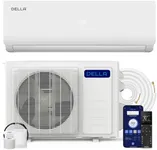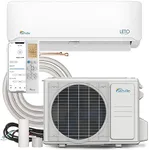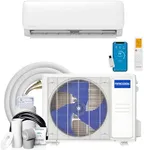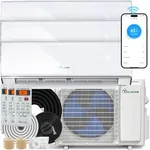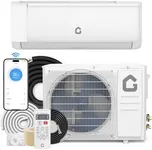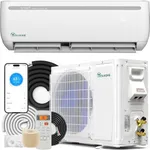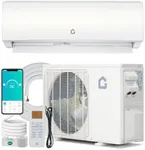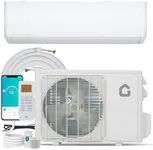Buying Guide for the Best Mini Split Systems
Choosing the right mini-split system can significantly improve the comfort of your home or office. Mini-split systems are a type of air conditioning system that allows for individual temperature control in different rooms or zones. They are known for their energy efficiency, ease of installation, and flexibility. To make an informed decision, it's important to understand the key specifications and how they relate to your specific needs.BTU CapacityBTU (British Thermal Unit) capacity measures the cooling or heating power of the mini-split system. This is important because it determines how effectively the system can regulate the temperature in a given space. BTU capacity ranges from around 9,000 to 36,000 BTUs. For small rooms (up to 300 sq. ft.), a system with 9,000-12,000 BTUs is usually sufficient. Medium-sized rooms (300-600 sq. ft.) typically require 12,000-18,000 BTUs, while larger spaces (600-1,000 sq. ft.) may need 18,000-24,000 BTUs. For very large areas, you might need a system with 24,000-36,000 BTUs. Choose a BTU capacity that matches the size of the room or area you want to cool or heat.
SEER RatingSEER (Seasonal Energy Efficiency Ratio) rating measures the energy efficiency of the mini-split system. A higher SEER rating indicates better energy efficiency, which can lead to lower energy bills. SEER ratings typically range from 13 to 30. Systems with a SEER rating of 13-16 are considered standard efficiency, 17-20 are high efficiency, and 21 and above are ultra-high efficiency. If you prioritize energy savings and environmental impact, opt for a system with a higher SEER rating.
Number of ZonesThe number of zones refers to how many separate areas or rooms the mini-split system can independently control. This is important for customizing the temperature in different parts of your home or office. Systems can range from single-zone (one indoor unit) to multi-zone (multiple indoor units). Single-zone systems are ideal for cooling or heating one specific area, while multi-zone systems are better for larger homes or offices with multiple rooms. Consider the layout of your space and how many areas you need to control when choosing the number of zones.
Indoor Unit TypeThe indoor unit type refers to the design and installation method of the unit inside the room. Common types include wall-mounted, ceiling cassette, floor-mounted, and ducted units. Wall-mounted units are the most popular and easiest to install, suitable for most rooms. Ceiling cassette units are installed in the ceiling and are ideal for rooms with limited wall space. Floor-mounted units are placed near the floor and are good for rooms with low ceilings. Ducted units are hidden within the ceiling or walls and are best for a more discreet look. Choose the indoor unit type based on your room's layout and aesthetic preferences.
Noise LevelNoise level is measured in decibels (dB) and indicates how loud the mini-split system will be during operation. This is important for maintaining a comfortable and quiet environment. Noise levels for mini-split systems typically range from 19 dB to 60 dB. Systems with noise levels below 30 dB are considered very quiet and are ideal for bedrooms or offices. Noise levels between 30-50 dB are moderate and suitable for living rooms or kitchens. Systems above 50 dB may be noticeable and are better suited for areas where noise is less of a concern. Consider where the system will be installed and choose a noise level that ensures comfort.
Heating CapabilityHeating capability refers to the mini-split system's ability to provide heat in addition to cooling. This is important if you live in a region with cold winters and need a year-round solution. Some mini-split systems are cooling-only, while others offer both heating and cooling (heat pump systems). Heat pump systems can efficiently heat your space even in colder temperatures. If you need a system that can handle both heating and cooling, look for a mini-split with heat pump functionality.
